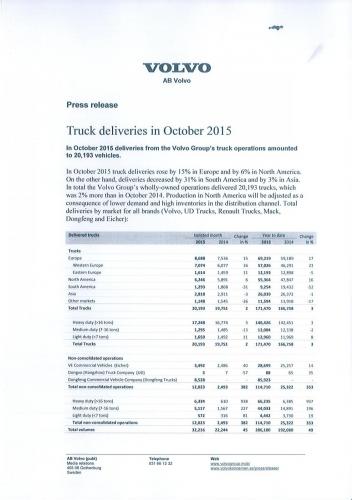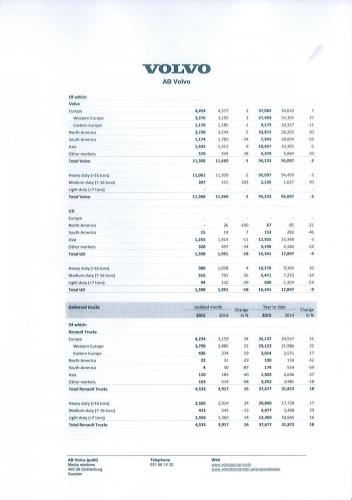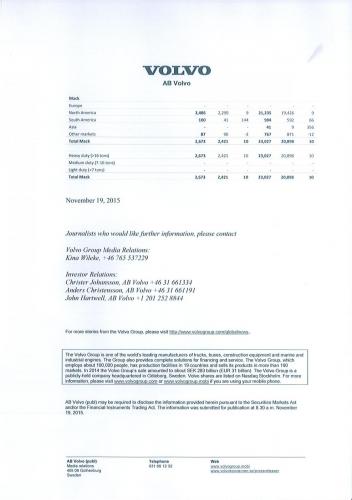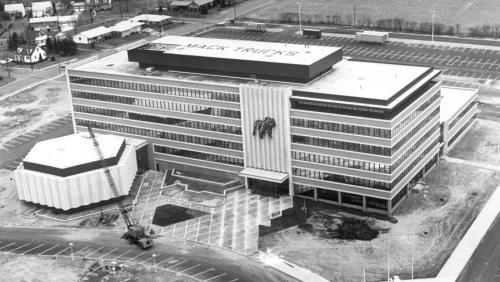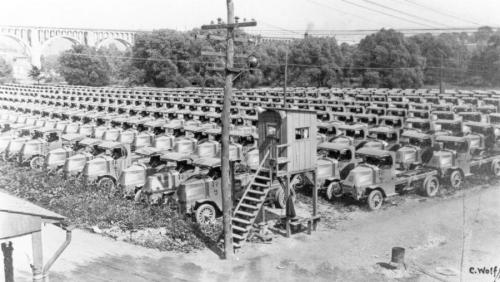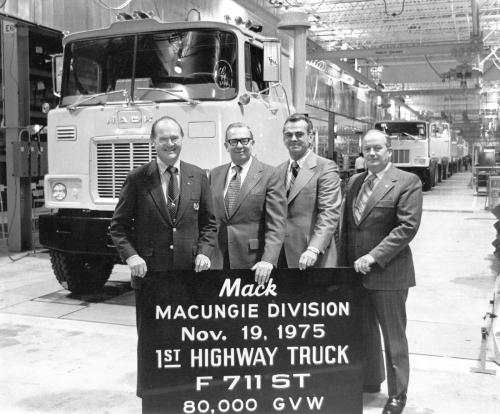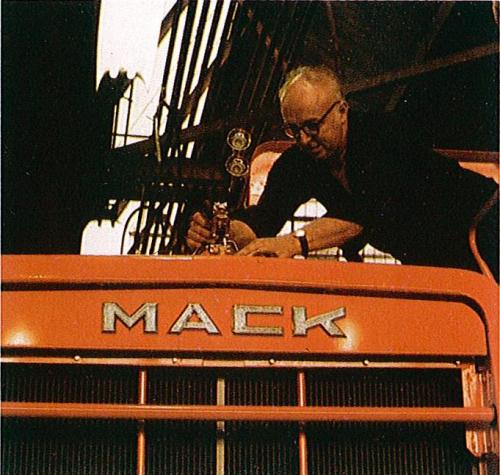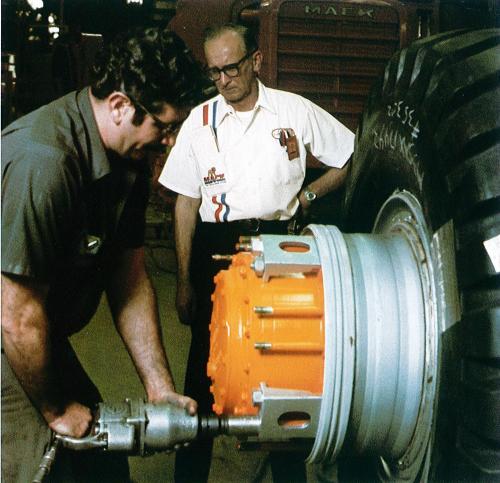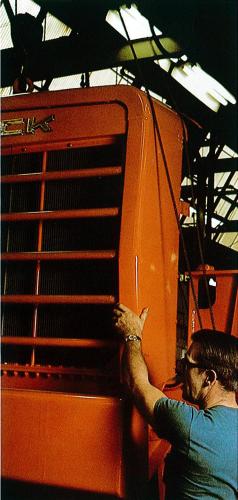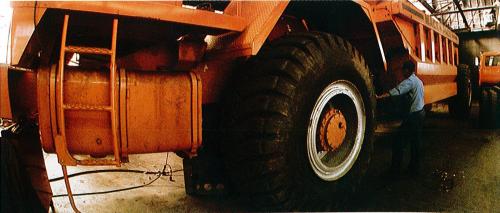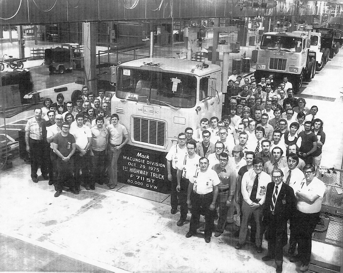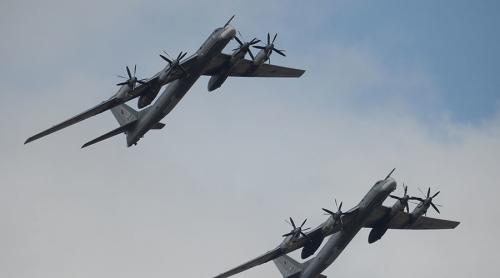
kscarbel2
Moderator-
Posts
18,549 -
Joined
-
Days Won
112
Content Type
Profiles
Forums
Gallery
Events
Blogs
BMT Wiki
Collections
Store
Everything posted by kscarbel2
-
Daimler to invest $375 million to build diesel engines near Detroit
kscarbel2 replied to kscarbel2's topic in Trucking News
Detroit ‘completes the hat trick’ with DT12 production brought to Michigan Truck News / November 21, 2015 In a hockey-themed plant inauguration, Daimler Trucks’ Detroit brand celebrated the start of production of its DT12 automated manual transmission and announced the launch of its mid-range engine line here Friday. The hot-selling DT12 was previously built in Gagenau, Germany and shipped to North America for installation in Freightliner and Western Star trucks. Daimler pumped US$100 million into its Redford, Mich. plant to bring production to these shores. “More than 40% of our Freightliner Cascadia and Western Star trucks are sold with an automated transmission and the take rate is still climbing,” said Dr. Wolfgang Bernhard, head of Daimler trucks globally. “It is a huge success and it makes us really proud. It is now time to make the next step; it’s my pleasure today to announce the start of production of our DT12 right here in the US, right here in Detroit, right here in Redford.” Production at the plant was momentarily halted to celebrate the milestone and about 2,000 employees, media and dignitaries gathered to hear Bernhard’s remarks. The plant inauguration was emceed by former Detroit Red Wing Micky Redmond. It was also attended by a beaming Roger Penske, who bought the company in 1988, saved it from potential bankruptcy, turned it around on the success of the Series 60 and then sold it to Daimler. “I didn’t know what I was getting into but it was an opportunity,” Penske said, noting at the time the company had lost $600 million in three years, languished with 3% market share and was suffering strained relations with employees. “I’m proud to see what is taking place today.” Martin Daum, CEO of Daimler Trucks North America, said the company has “completed the hat trick” by bringing DT12 production to Redford, where it also builds its heavy-duty engines and axles. “We now manufacture the entire powertrain lineup – engines, axles and transmission – right here in Detroit and that means we can integrate, synchronize, make it perfect,” said Bernhard. “We can offer the most powerful powertrain in the country and it gives our customers more reason to demand Detroit.” Daimler also announced the launch of its medium-duty DD5 and DD8 engines, which will also be built in Redford, eventually. Configuring the plant for the mid-range engines represents another US$375-million investment into the facility. “Today, we complete our lineup,” said Bernhard. “We launch our new medium-duty engines, the DD5 and DD8 into the US market and what’s more, we’re not only going to sell them in the US, but by 2018 we will also build them right here in Detroit, right here in Redford.” With the new engine launch, Daimler says it will bring the benefits of vertical integration seen on the heavy-duty side to the medium-duty market. “Detroit medium-duty engines will provide what no other manufacturer in North America can offer – a total vehicle solution that matches Daimler’s global engineering prowess with the most complete lineup bar none in the industry,” said Daum. “I am pleased to announce that select Daimler Truck North America vehicles will be available with medium-duty power by the end of 2016, and full production will take place in Detroit by the end of 2018.” In a press conference following the plant inauguration, Daum said Daimler will continue with its two-supplier strategy, offering Cummins engines as well in its medium-duty trucks. “This won’t change our business with Cummins because we have in every segment a two-supplier strategy. We want to give our customers choice and ultimately it’s the customers that are going to decide,” Daum said. When medium-duty engine production is brought to Michigan in 2018, it will add about 160 new jobs. Until then, they’ll be produced in Mannheim, Germany. The new engines will be available for order in 2016 in the Freightliner M2. Details regarding engine ratings and other specific features of the new mid-range engines were not yet revealed. Daimler Trucks North America has in recent years become a stronger player in the medium-duty market, capturing about 40% of the US Classes 6/7 segments in each of the past few years. Daimler also announced its entire lineup will comply with impending 2017 greenhouse gas emissions requirements early. Daum said he expects the truck market to remain strong in 2016, though orders will likely land somewhere between an excellent 2015 and a very good 2014. “We will finish the year strong and the start of the year will be strong through the first quarter,” Daum said. “We’ll see how the rest of the year unfolds. We don’t have that security we had a year ago where we were sold out at the beginning of the year but this is not normal for business, you should every day worry for your business and fight for it.” -
Truck OEMs Aim for New Breed of ‘Low-Cost’ Models Trailer/Body Builders / January 18, 2011 Research firm Frost & Sullivan has unveiled a detailed analysis of what it calls the “low cost truck” movement, a strategic initiative by truck manufacturers either individually or through joint ventures that will completely reshape the types of commercial vehicles used around the world. “What we’re seeing is a determined effort to build trucks that cost 20% to 25% less in any given global market – from North America to Brazil, Russia, and Europe,” Sandeep Kar, global program manager--commercial vehicle research for Frost & Sullivan, told Fleet Owner. “And this effort will cover the entire commercial vehicle spectrum, from light- to medium- and heavy-duty models.” For the study – titled Strategic Analysis of the Global Low Cost Truck Market – Frost & Sullivan interviewed OEMs and suppliers from around the world, conducted its own research, and then made near-term projections for the low-cost strategy spanning 2010 to 2016. Kar said the firm’s research indicates new low-cost price ranges will develop as follows: $4,000 to $20,000 for a light commercial vehicle (LCV); $15,000 to $40,000 for a medium commercial vehicle (MCV); and $30,000 to $70,000 for a heavy commercial vehicle (HCV). According to Kar, the impetus for this strategy on the part of truck builders is that commercial fleets are simply under far too much bottom-line pressure today – paying for higher fuel prices, the cost of regulatory compliance, higher pay to compete for workers – to afford ever-higher sticker prices on new equipment. Dahlman Rose transportation economist Jason Siedl noted at FTR Associates’ annual freight outlook conference last September that the average cost for a new Class 8 tractor is up to $120,000 in the U.S. One fleet at that meeting said that its Class 8 tractor costs increased $25,000 per unit from 2002 to 2010. It’s the financial pressure those high prices put on U.S. fleet owners that in turn is driving the effort to create low cost trucks, said Frost & Sullivan’s Kar. “We expect to see phenomenal growth in the North American market for low cost trucks,” Kar pointed out. “Our research indicates the average base price point for a heavy-duty truck in North America is about $104,000. Now say some $10,000 to $15,000 worth of emission control and safety systems need to be added to the low-cost truck platform to bring it into regulatory compliance. You’d still be looking at a truck that is $80,000 to $95,000-- still cheaper than current prices today.” Of course, such low- cost trucks would not contain the same amenities found on many of today’s commercial vehicles – especially in terms of driver-comfort specs. For that reason, Frost & Sullivan contends the North American truck market will become two-tiered, having a low-cost and a premium segment, with mid-priced models disappearing. We would also not see the low-cost model challenge the long-haul Class 8 sleeper segment,” he noted. “Rather, we’d see the low-cost Class 8 model dominate the short-haul daycab segment.” The key to making these low-cost trucks a reality, however, will rest on creating a far larger global manufacturing scale than exists now-- along with a global supplier network. “Making a low-cost truck means cutting costs throughout the vehicle,” Kar observed. Per Frost & Sullivan, areas where costs will be cut include: 5% to 8% from powertrains 3% to 4% from chassis 3% to 4% from driver comfort and amenities 3% to 4% from engines 1% to 2% from marketing efforts Overall, total production costs for a low- cost truck platform should fall anywhere from 19% to 29%, Kar said. Yet can the low-cost trucks find willing fleet buyers in the U.S.? Kar definitely thinks so. “Total cost of ownership or ‘TCO’ is now the most critical metric within most fleets,” he explained. “Access to financing is still limited and after the recent economic downturn, fleets still have little cash to spend,” Kar added. “In a way, fleets will almost be forced to look at low-cost truck models due to the operating conditions they will continue to face.”
-
Trailer/Body Builders / November 20, 2015 The convergence of premium and low-cost trucks has led to the evolution of a mid-market segment, referred to as value trucks. Medium- and heavy-duty value trucks will emerge as the fastest-growing segment globally, with sales volumes of over a million units by 2022, with approximately 80 percent of these sales expected from China, India, Africa and Indonesia. Of this, 70 percent will be from China and India, prompting original equipment manufacturers (OEMs) to focus on developing platforms for these two markets in the short-medium term. Additionally, OEMs to ensure the platforms feature attributes enabling global scalability in the long-term. New analysis from Frost & Sullivan, Executive Analysis of Medium-Duty and Heavy-Duty Value Truck Market in Select Emerging Economies (http://bit.ly/1QeghNx), finds mid-market value trucks represent the most attractive sub-segment for platform development. By 2020, 75 percent of all value trucks built globally will be attributed to platform-based development and manufacturing. “Global value truck OEMs and suppliers should realign product and service strategies to cater to the expanding mid-market,” said Frost & Sullivan Commercial Vehicles Program Manager Bharani Lakshminarasimhan. “Multi-pronged market strategies will fetch desirable results, as both the premium and value truck segments offer substantial opportunities for growth.” MD-HD value truck OEMs are targeting the premium truck market through value re-positioning of products to lower the loss of market share to low-cost trucks. Additionally, MD-HD value truck OEMs must cater to fleet requirements for a low cost of ownership, strong safety features and high reliability to prosper in emerging markets. “Creating value clusters through incremental technology advancements or enhanced sophistication of base platforms are key for optimal positioning in the MD-HD value truck market,” noted Lakshminarasimhan. “Therefore, MD-HD value truck OEMs should look at developing global platforms for low cost-centric markets and offer plug-in value solutions and services for market entry and growth.”
-
Paul, you couldn't be more right.
-
Daimler to invest $375 million to build diesel engines near Detroit
kscarbel2 replied to kscarbel2's topic in Trucking News
Daimler Kicks Off Production of AMTs in North America for First Time Transport Topics / November 20, 2015 Daimler Trucks North America officially launched production of its Detroit-branded DT12 automated manual transmission on Nov. 20, while simultaneously announcing a $375 million investment to produce medium-duty engines here in 2018. “Our investment is a tangible example of how we maximize the use of our global platforms optimized for regional markets,” said Wolfgang Bernhard, head of Daimler’s global truck and bus unit. Daimler officials, including President Martin Daum, were joined by Michigan Gov. Rick Snyder and nearly 2,000 UAW workers at the plant located just outside Detroit for a celebration that came 35 months after President Obama toured the same facility. It was during that visit by Obama that DTNA originally announced its intention to make transmissions outside of Germany for the first time. The company invested $100 million and created 170 new jobs to make it a reality. Earlier this year, Daum said demand for AMTs was outpacing the company’s ability to produce them. The AMT is available on the Freightliner Cascadia and Western Star 5700XE models. In recent years, several truck manufacturers have been pushing a vertical integration strategy. In Daimler’s case, the powertrain brings together a Detroit engine, transmission and axles. The company said the powertrain is part of its effort to have uniform global production standards. Daimler actually began making the DT12s about four weeks ago and is producing about 120 per day. Meanwhile, DTNA initially announced its intention to produce the DD5 and DD8 medium-duty engines in October 2014. At the time, Daum said the engines would be exported from Germany starting in 2016, with North American development expected in 2018. “Michigan has long been the world’s automotive leader, and we are proud that Daimler will continue to play a big role in our state’s reinvention moving forward. This is an investment in Detroit and the hard-working people of Michigan,” Snyder said. DTNA said the DD5 and DD8 lines will add about 160 new jobs to the Detroit facility. The engines will meet 2017 greenhouse-gas standards. -
Daimler to invest $375 million to build diesel engines near Detroit
kscarbel2 replied to kscarbel2's topic in Trucking News
Daimler Trucks to Bring New Detroit Medium-Duty Engine Line to U.S. Heavy Duty Trucking / November 20, 2015 Daimler Trucks Friday announced a $375 million investment to enable production of the new DD5 and DD8 medium-duty engines at Detroit’s Redford, Mich., plant. Joined by Michigan Gov. Rick Snyder and nearly 2,000 UAW workers, Daimler Trucks celebrated the announcement of the new lines of DD5 and DD8 medium-duty engines and officially launched production of the company’s Detroit DT12 automated manual transmission. The new engines, first announced at the 2014 American Trucking Associations annual conference, will be available in select Daimler Truck North America vehicles by the end of 2016. Full production will take place in Detroit by the end of 2018, according to Martin Daum, president and CEO of Daimler Trucks North America. The engines will be initially built and shipped from Daimler’s powertrain facility in Mannheim, Germany, with industrialization at the Detroit facility in 2018. DTNA’s entire product line-up, including vehicles equipped with the DD5 and DD8, will meet federal 2017 greenhouse gas/fuel economy standards early. The theme of the day was “Built in Detroit,” and celebrated the long successful history of Detroit powertrain manufacturing at the Detroit brand Headquarters. “Our investment is a tangible example of how we maximize the use of our global platforms optimized for regional markets,” said Wolfgang Bernhard, Daimler AG Board of Management member responsible for trucks and buses. “'Built in Detroit' is not just a marketing slogan; it is our commitment to strengthen the industrial base in Detroit and to deliver the most fuel-efficient engines to our customers. I am convinced: With our medium-duty engines we will repeat the success story of our best-selling heavy-duty engines.” The new Detroit DD5 and DD8 engine development is another example of Daimler’s international development effort, with global testing and validation being undertaken in both Europe and the United States, and series production in Europe since 2012. For sale in limited quantities, the Detroit DD5 medium-duty engine will be available in 2016 on the Freightliner M2 product line, with extensive availability in 2018 across DTNA’s product portfolio including Freightliner, Western Star, Thomas Built Buses, and Freightliner Custom Chassis vehicles. The “Built in Detroit” event also celebrated the production commencement of Detroit’s DT12 automated manual transmissions. With the launch Friday, the company is delivering on the commitment made during President Obama’s visit to the Redford facility in December 2012. -
I noted and respect the opinions (thoughts) expressed by you and David Wild. (facts?) Given that you've never met me, and know nothing about me..........I'm surprised that you nonetheless can say that you have zero respect for me (your right, of course). Left views? Sorry, you lost me there. My posts were only about presenting a more detailed picture of the significant situation unfolding (what CNN does not present). David Wild's first post includes numerous derogatory remarks. I'm confident that he could have expressed his views on a higher plane than that.
-
Most Americans, through no fault of their own, are unaware of the the full extent of what's actually occurring around the world. The international news is but one side of one page in their local newspaper. CNN, ABC and NBC kowtow to the government line. So far as facts go, as I have already said, at any one time, the common people are only privy to around 15 to 20 percent of the facts on what's occurring in the world, who'd doing it, and why. The rest is hidden from view. I'm confident you're in agreement with that. I did include a couple of op-eds from Reuters, Time and The Financial Times (excellent reporting) that I felt provided excellent insight. The op-ed above from the Pulitzer Prize-winning Guardian is an excellent read (my opinion). The Guardian tends to report the truth, rather than sing the party line. Of course, I also posted several key news articles.
-
Reuters / November 20, 2015 The head of Daimler AG's commercial truck operation said the company will invest $375 million at a complex near Detroit to build diesel engines for medium trucks, expanding a strategy of building and selling trucks, engines, transmissions and axles as a package. The 5-liter DD5 and 8-liter DD8 are Daimler’s new generation medium-duty diesels introduced in Europe three years ago. The proprietary diesels will be available in the Freightliner M2 starting next year with initial engines built in Daimler’s Mannheim, Germany plant. Full U.S. production of the MD engines is scheduled for the end of 2018 and availability will then be expanded to DTNA’s Western Star, Freightliner, Custom Chassis and Thomas Built Bus brands. Currently Cummins supplies all of DTNA’s medium-duty engines. Once the Detroit engines are introduced, the company will continue to offer Cummins engines as an option, according to Martin Daum, president and CEO of DTNA. “The success of our integrated powertrain for heavy-duty vehicles in the US is phenomenal, said Wolfgang Bernhard, head of the Daimler Trucks and Bus business during the inauguration ceremonies. “Already, over 40% of the Freightliner Cascadia models are supplied with the DT12 automated manual transmission. So, naturally, it makes sense to now also produce this bestseller locally. … And I am really excited, that in the future we will also produce our medium duty engines DD5 and DD8 here. This is a major step in executing our global platform strategy.” Daimler had previously expanded its Detroit operations to produce automated manual transmissions for heavy trucks, which have been "a runaway success," said Wolfgang Bernhard, head of Daimler's global commercial truck operations. Bernhard said he expects demand for medium and heavy trucks will be "slightly softer" in North America next year, but should still be above relatively strong 2014 levels. European demand will be flat and Brazil will "continue to be very difficult," he said. Earlier this week, rival truck maker AB Volvo said it planned to idle its North American factories for a total of 2.5 weeks in December and January to reduce swelling inventories. Bernhard said Daimler, which controls about 40 percent of the U.S. heavy truck market, is not cutting back. Production at its Detroit engine and transmission factories is still running around the clock, seven days a week, he said. Daimler's latest investment in Detroit builds on a strategy Bernhard has pursued to bring engineering and manufacturing of the company's commercial trucks under one roof. Traditionally, especially in North America, heavy truck makers such as Paccar and Navistar have purchased engines, transmissions, axles and other major components from suppliers such as Cummins, Eaton, Caterpillar and Dana. Government demands to cut carbon dioxide emissions are putting more pressure on commercial vehicle makers. Bernhard said Daimler's response will be to design and engineer itself more of the technology in its vehicles. "We can perfectly optimize those components to each other to get the best fuel economy and reliability," he said. Bernhard said Daimler is also using its own technology to develop autonomous driving systems for future commercial vehicles. He said trucks that could drive themselves on open freeways could be available by 2020. Daimler is testing autonomous driving technology on heavy trucks in Germany and the United States. Press Release - http://media.daimler.com/dcmedia/0-921-656186-1-1867081-1-0-0-0-0-1-0-1549054-0-1-0-0-0-0-0.html?TS=1448246422942
-
"People should and do trust me" - Hillary Clinton
kscarbel2 replied to kscarbel2's topic in Odds and Ends
$3 billion over 41 years: How the Clintons methodically cultivated donors https://www.washingtonpost.com/graphics/politics/clinton-money/ -
This is a must-read, to better understand how the Middle East arrived at its latest dire situation. ------------------------------------------------------------------------------------------ How the US fueled the rise of ISIS in Syria and Iraq The Guardian / June 3, 2015 The war on terror, that campaign without end launched 14 years ago by George Bush, is tying itself up in ever more grotesque contortions. On Monday, the trial in London of a Swedish man, Bherlin Gildo, accused of terrorism in Syria, collapsed after it became clear British intelligence had been arming the same rebel groups the defendant was charged with supporting. The prosecution abandoned the case, apparently to avoid embarrassing the intelligence services. The defence argued that going ahead with the trial would have been an “affront to justice” when there was plenty of evidence the British state was itself providing “extensive support” to the armed Syrian opposition. That didn’t only include the “non-lethal assistance” boasted of by the government (including body armour and military vehicles), but training, logistical support and the secret supply of “arms on a massive scale”. Reports were cited that MI6 had cooperated with the CIA on a “rat line” of arms transfers from Libyan stockpiles to the Syrian rebels in 2012 after the fall of the Gaddafi regime. Clearly, the absurdity of sending someone to prison for doing what ministers and their security officials were up to themselves became too much. But it’s only the latest of a string of such cases. Less fortunate was a London cab driver Anis Sardar, who was given a life sentence a fortnight earlier for taking part in 2007 in resistance to the occupation of Iraq by US and British forces. Armed opposition to illegal invasion and occupation clearly doesn’t constitute terrorism or murder on most definitions, including the Geneva Convention. But terrorism is now squarely in the eye of the beholder. And nowhere is that more so than in the Middle East, where today’s terrorists are tomorrow’s fighters against tyranny – and allies are enemies – often at the bewildering whim of a western policymaker’s conference call. For the past year, US, British and other western forces have been back in Iraq, supposedly in the cause of destroying the hyper-sectarian terror group Islamic State (formerly known as al-Qaida in Iraq). This was after ISIS overran huge chunks of Iraqi and Syrian territory and proclaimed a self-styled Islamic caliphate (https://en.wikipedia.org/wiki/Caliphate). The campaign isn’t going well. Last month, ISIS rolled into the Iraqi city of Ramadi, while on the other side of the now nonexistent border its forces conquered the Syrian town of Palmyra. Al-Qaida’s official franchise, the Nusra Front, has also been making gains in Syria. Some Iraqis complain that the US sat on its hands while all this was going on. The Americans insist they are trying to avoid civilian casualties, and claim significant successes. Privately, U.S. officials say they don’t want to be seen hammering Sunni strongholds in a sectarian war and risk upsetting their Sunni allies in the Gulf. A revealing light on how we got here has now been shone by a recently declassified secret US intelligence report, written in August 2012, which uncannily predicts – and effectively welcomes – the prospect of a “Salafist principality” in eastern Syria and an al-Qaida-controlled Islamic state in Syria and Iraq. In stark contrast to western claims at the time, the Defense Intelligence Agency document identifies al-Qaida in Iraq (which became ISIS) and fellow Salafists as the “major forces driving the insurgency in Syria” – and states that “western countries, the Gulf states and Turkey” were supporting the opposition’s efforts to take control of eastern Syria. Raising the “possibility of establishing a declared or undeclared Salafist principality”, the Pentagon report goes on, “this is exactly what the supporting powers to the opposition want, in order to isolate the Syrian regime, which is considered the strategic depth of the Shia expansion (Iraq and Iran)”. American forces bomb one set of rebels while backing another in Syria Which is pretty well exactly what happened two years later. The report isn’t a policy document. It’s heavily redacted and there are ambiguities in the language. But the implications are clear enough. A year into the Syrian rebellion, the US and its allies weren’t only supporting and arming an opposition they knew to be dominated by extreme sectarian groups; they were prepared to countenance the creation of some sort of “Islamic state” – despite the “grave danger” to Iraq’s unity – as a Sunni buffer to weaken Syria. That doesn’t mean the US created ISIS, of course, though some of its Gulf allies certainly played a role in it – as the US vice-president, Joe Biden, acknowledged last year. But there was no al-Qaida in Iraq until the US and Britain invaded. And the US has certainly exploited the existence of ISIS against other forces in the region as part of a wider drive to maintain western control. The calculus changed when ISIS started beheading westerners and posting atrocities online, and the Gulf states are now backing other groups in the Syrian war, such as the Nusra Front. But this US and western habit of playing with jihadi groups, which then come back to bite them, goes back at least to the 1980s war against the Soviet Union in Afghanistan, which fostered the original al-Qaida under CIA tutelage. It was recalibrated during the occupation of Iraq, when US forces led by General Petraeus sponsored an El Salvador-style dirty war of sectarian death squads to weaken the Iraqi resistance. And it was reprised in 2011 in the Nato-orchestrated war in Libya, where ISIS last week took control of Gaddafi’s home town of Sirte. In reality, US and western policy in the conflagration that is now the Middle East is in the classic mould of imperial divide-and-rule. American forces bomb one set of rebels while backing another in Syria, and mount what are effectively joint military operations with Iran against ISIS in Iraq while supporting Saudi Arabia’s military campaign against Iranian-backed Houthi forces in Yemen. However confused US policy may often be, a weak, partitioned Iraq and Syria fit such an approach perfectly. What’s clear is that ISIS and its monstrosities won’t be defeated by the same powers that brought it to Iraq and Syria in the first place, or whose open and covert war-making has fostered it in the years since. Endless western military interventions in the Middle East have brought only destruction and division. It’s the people of the region who can cure this disease – not those who incubated the virus.
-
Volvo Group - Truck deliveries in October 2015
kscarbel2 replied to kscarbel2's topic in Trucking News
Volvo's truck deliveries increased Sydsvenskan / November 19, 2015 Volvo Group's truck deliveries rose to 20,193 vehicles in October, an increase of 2 percent compared with the same month in 2014. The increase was unexpected. Analysts had expected an unchanged delivery volume. For the year to date, October figures show a rise of 3 percent to 171,470 trucks delivered. In Europe, October sales rose 15 percent to 8,688 vehicles. Sales in North America rose 6 percent to 6,246 vehicles. In South America, there was also a sharp incline, with a reduction in deliveries of 31 percent to 1,293 vehicles. In Asia, there was also a decline of 3 percent to 2,818 vehicles. Deliveries of heavy trucks over 16 tons rose 3 percent to 17,248 vehicles. Medium-duty truck sales (7-16 tons) fell 13 percent to 1,295 vehicles. Light truck sales (under 7 tons) rose 11 percent to 1,650 vehicles. The monthly figures include truck sales for the Volvo, UD Trucks, Renault Trucks, Mack, Dongfeng and Eicher brands. -
AB Volvo Press Release / November 19, 2015 In October 2015 deliveries from the Volvo Group’s truck operations amounted to 20,193 vehicles. In October, Volvo Group truck deliveries rose by 15% in Europe and by 6% in North America. On the other hand, deliveries decreased by 31% in South America and by 3% in Asia. In total, Volvo Group’s wholly-owned operations* delivered 20,193 trucks, which was 2% more than in October 2014. Volvo brand global sales reached 11,368 units, including 3,738 deliveries in North America, down 1 percent globally but up 5 percent in North America compared to October 2014. Mack brand global sales reached 2,673 units, including 2,486 deliveries in North America, up 10 percent globally and 9 percent in North America compared to October 2014. Renault brand global sales reached 4,533 units, up 16 percent globally and 34 percent in Europe compared to October 2014. Production in North America will be adjusted [decreased] as a consequence of lower demand and high inventories in the distribution channel. * Excluding Eicher, Dongvo and Dongfeng .
-
Kenworth Truck Company Press Release / November 19, 2015
-
Kenworth Truck Company Press Release / November 19, 2015
-
Mack’s Macungie plant marks 40 year anniversary
kscarbel2 replied to kscarbel2's topic in Trucking News
Mack World Headquarters under construction at 2100 Mack Boulevard in Allentown, Pennsylvania in 1969, under Zenon C.R. Hansen's leadership "The Truck Capital of the World." Construction began in 1967, and it was completed in late 1969. Mack World Headquarters was officially opened in April 28, 1970. . -
Mack’s Macungie plant marks 40 year anniversary
kscarbel2 replied to kscarbel2's topic in Trucking News
Mack AC trucks stored along Lawrence Street (now Martin Luther King Jr. Boulevard) in Allentown in 1918, awaiting shipment to Europe. This is the truck that gave the company its name. Mack Trucks, then known as the International Motor Co., was another local company that had its identity shaped by the war. The company had come to Allentown in 1905 from New York and was headed by the Mack brothers, Jack, William, and Augustus or ‘Gus,’ and was already well known as a maker of buses and trucks. By 1914 it had merged with a number of other truck companies to become the International Motor Co. Its major contribution to the war effort was the sturdy, rugged Mack AC truck. In 1917 about 150 of these trucks, with their distinctive front that resembles a face, were sold to the British. . -
Mack’s Macungie plant marks 40 year anniversary
kscarbel2 replied to kscarbel2's topic in Trucking News
Today marks 40 years of manufacturing for Mack's Lower Macungie plant The Morning Call / November 19, 2015 Forty years ago Thursday, Mack Trucks' then-new manufacturing facility in Lower Macungie Township completed its first highway truck, a Mack F711ST model. Now, all Mack trucks built for the North American market are assembled at the sprawling 1 million-square-foot facility. The facility also assembles Mack trucks for export to countries outside North America, such as Venezuela and Peru. "Over the past 40 years, we have proudly assembled thousands of Mack models for customers around the world," Stephen Roy, president of Mack Trucks North America, said in a statement. "Each employee's precision and dedication also has helped solidify Mack's reputation for building some of the toughest, highest-quality and most durable trucks on the road." The local plant had another productive month in October, according to a report released Thursday by Mack's parent company, the Sweden-based Volvo Group. Mack delivered 2,673 trucks worldwide in October, up 10 percent from 2,421 one year earlier. Of those trucks, 2,486 — 93 percent of the worldwide total — were delivered in North America. Heavy truck production is expected to peak this year. For example, Volvo expects the total North American retail market for heavy-duty trucks to approach 310,000 trucks in 2015. The company is anticipating lower — but still solid — demand of 280,000 trucks in 2016. To adjust to the market, the local Mack plant will likely be hit with layoffs. Mack spokesman Christopher Heffner said in an email Thursday "it's still too soon to say how many employees will be affected." Construction of the Lower Macungie plant moved fast. Site preparation for the facility began in May 1974, Mack said, with construction beginning shortly thereafter. The massive plant was completed in less than one year. The plant's layout was designed in-house by Mack employees to "maximize manufacturing efficiency and flexibility," the company said. But the plant now requires some refurbishing. Wade Watson, vice president and general manager of Mack's Lehigh Valley operations, said last week that Mack wants to expand the building's south end by adding receiving docks, which would improve efficiency, and a new facade, aimed at boosting customer experience. If all goes according to plan, Watson said he hopes to have both improvements completed by the end of 2017. "We're committed to the Lehigh Valley," Watson said Nov. 11. "We're looking at ways to invest and make it a more efficient operation here, so that's the intent." While looking to increase productivity, Mack's Lower Macungie plant is already a model of energy efficiency. In 2013, Mack announced the facility was the first U.S. manufacturing facility to receive a platinum-level Superior Energy Performance certification in the Mature Energy Pathway category. The certification acknowledged the plant improved its energy performance by nearly 42 percent between 2002-03 and 2012-13. Employment at Mack has also changed over time. A 700-strong workforce produced some of the first trucks at the Lower Macungie plant, which pumped out Mack CF model fire apparatus, Mack F model cabover highway trucks and off-highway models like the Mack M series mining trucks and the Mack Pack articulated bottom dump. Now, Mack has 1,866 employees locally. That's up from 812 in the Lehigh Valley in December 2009. The Lower Macungie plant has been commemorating its 40th anniversary throughout this year. Employee celebrations took place earlier this summer and banners and branding have been displayed in the facility. In conjunction with the anniversary, Mack also announced it would be changing the name of the facility from Macungie Cab & Vehicle Assembly to Mack Lehigh Valley Operations. "This new name identifies our heritage, but also more accurately captures our operational footprint and the contributions of our employees who live throughout the region," Watson said in a statement Thursday. "Although we are celebrating four decades of success at our plant, we have been revitalizing the facility with innovative systems and tools that already give our operation a very modern feel, and we are not yet complete with our updates." The new facility name will begin to appear on signage and other material in the coming weeks, Mack said. . -
Fleet Owner / November 19, 2015 First Mack highway truck assembled at the Lehigh Valley Operations manufacturing facility – an F711ST model – rolled off its production line on Nov. 19, 1975. Today all Mack trucks are assembled at the facility. Mack Trucks noted that its Lehigh Valley Operations manufacturing facility Mack, located in Lower Macungie Township, PA, crossed the four-decade mark on Nov. 19 this year. Site preparation for the one million square-foot facility began in May 1974, with construction completed in less than one year. The plant’s layout was designed in-house by Mack employees, without the help of outside consultants, to maximize manufacturing efficiency and flexibility. With a 700-strong workforce, the first trucks produced at Mack Lehigh Valley Operations included Mack CF model fire apparatus, Mack F model cabover highway trucks and off-highway models like the Mack M series mining trucks and the Mack Pack articulated bottom dump. In conjunction with this anniversary mark, Mack said it is changing the name of the facility from Macungie Cab & Vehicle Assembly to Mack Lehigh Valley Operations, highlighting the site’s regional impact. “This new name identifies our heritage, but also more accurately captures our operational footprint and the contributions of our employees who live throughout the region,” said Wade Watson, VP and GM of Mack Lehigh Valley Operations. “Although we are celebrating four decades of success at our plant, we have been revitalizing the facility with innovative systems and tools that already give our operation a very modern feel, and we are not yet complete with our updates.” .
-
Transport Topics / November 19, 2015 Volvo will cut heavy-duty truck production in North America in December and January “as a consequence of lower demand and high inventories in the distribution channel,” it said in a press release Nov. 19. "In North America, we will take 2 1/2 stop weeks in addition to the normal Christmas and New Year's leave," Volvo spokeswoman Kina Wileke told Reuters. Volvo, which in North America sells trucks under its namesake brand as well as the Mack brand, said the production stops would take place on the Volvo Trucks side. During an earlier earnings-related conference call, acting CEO Jan Gurander said dealer inventory had reduced the order intake at both Volvo and Mack. Also, he said he expected the North American market to decline by about 10% in 2016, calling that a "normalization."
-
In the fight against ISIS, Russia isn’t taking prisoners RT / Op-Edge / November 18, 2015 The so-called Islamic State should have learned by now: they've picked a fight against the wrong guys. We have entered "take no prisoners" territory. For Russia, now all the gloves are off. Especially after online terrorist magazine Dabiq published a photo of the alleged bomb that downed the Metrojet airliner killing 224 people: a crude device inside a can of Schweppes, placed under a passenger seat. Also published were photos of passports of Russian victims, allegedly taken "by the mujahedeen." Their collective fate was sealed the minute the Director of the Federal Security Service Aleksandr Bortnikov told President Putin, about the Metrojet crash on October 31 in Egypt that: “We can say with confidence that this was a terrorist act.” Caliphate goons may run – in the deserts of ‘Syraq’ and beyond - but they can’t hide, as per Russia’s presidential message: “We will search for them everywhere - wherever they are hiding. We will find them in any spot on the planet and we will punish them.” The message comes with extra enticement; the $50 million bounty offered by the FSB for any information leading to the perpetrators of the Sinai tragedy. Putin’s message instantly turned heavy metal in the form of a massive, impressive Russian barrage over 140 Caliphate targets, delivered via 34 air-launched cutting-edge cruise missiles and furious action by Tu-160, Tu-22, and the Tu-95MC ‘Bear’ strategic bombers. This was the first time the Russian long-range strategic bomber force has been deployed since the 1980s Afghan jihad. And there’s more coming - to be stationed in Syria; an extra deployment of 25 strategic bombers, eight Su-34 ‘Fullback’ attack aircraft, and four Su-27 ‘Flanker’ fighter jets. The tanker truck riddle At the G-20 in Antalya, Putin had already unveiled who contributes to ISIS’s financing – complete with “examples based on our data on the financing of different [iSIS] units by private individuals.” The bombshell: ISIS’s cash, “as we have established, comes from 40 countries and, there are some of the G20 members among them.” It doesn’t take a Caltech genius to figure out which members. They’d better take the “you can run but you can’t hide” message seriously. Additionally, Putin debunked - graphically – to the whole G20 the myth of a Washington seriously engaged on the fight against ISIS: “I’ve shown our colleagues photos taken from space and from aircraft which clearly demonstrate the scale of the illegal trade in oil.” He was referring to ISIS’s oil smuggling tanker truck fleet, which numbers over 1,000. Acting on Russian satellite intelligence, the Pentagon then found tanker truck convoys stretching “beyond the horizon,” smuggling out stolen Syrian oil, and duly bombed 116 trucks. For the first time. And this in over a year that the ‘Coalition of the Dodgy Opportunists’ (CDO) is theoretically fighting ISIS. The only such bombing that happened before was by the Iraqi Air Force. The US “strategy”, which Obama recently turbocharged, is to bomb (aging) Syrian oil infrastructure currently expropriated and exploited by ISIS. Technically, this is the property of Damascus, and thus belongs to the Syrian people. And yet Washington seemed so far to be more focused on other “people” [Halliburton] who could make a bundle rebuilding the devastated infrastructure, disaster capitalism-style, in case “Assad must go” works. Russia once again went straight to the point. Bomb the transportation network – the oil truck convoys – not the oil infrastructure. That will eventually drive oil smugglers out of business. The key reason the Obama administration had not thought about this before is Turkey. Washington needs NATO member Ankara for the use of the Incirlik air base. And then there’s the sensitive subject of who profits from ISIS’s oil smuggling. Turkish Socialist party member Gursel Tekin has established that ISIS’s smuggled oil is exported to Turkey by BMZ, a shipping company controlled by Bilal Erdogan, the son of Turkish President Recep Tayyip Erdogan. At a minimum, this violates UN Security Council resolution 2170. Under the light of Putin’s message of going after anyone or any entity engaged in facilitating ISIS’s operations, Erdogan’s clan better come up with some really good excuses. That jihadi boot camp Putin’s vow to go after anyone or any entity that facilitates/collaborates with ISIS should logically imply a trip back to ‘Shock and Awe 2003’: the bombing, invasion and occupation of Iraq that created the conditions for the establishment of Al-Qaeda in Iraq, directed by Abu Musab al-Zarqawi up to 2006. The next significant step was Camp Bucca, near Umm Qasr in southern Iraq; a mini-Guantanamo where at least nine members of the future metastasis of al-Qaeda – Islamic State (IS) – was spawned. ISIS/ISIL/Daesh was born in an American prison. Abu Bakr al-Baghdadi (a.k.a. Caliph Ibrahim) did time there, as well as ISIS’s previous number two, Abu Muslim al-Turkmani, and most of all ISIS’s conceptualizer: Haji Bakr, a former colonel in Saddam Hussein’s Air Force. Hardcore Salafi-jihadist meet former Ba’athist notables and find a common purpose; an offer the Pentagon could not refuse and in fact - willfully - let prosper. GWOT (the Global War on Terror), after all, is a Cheney-Rumsfeld-coined “Endless War”. The US neoconservative (https://en.wikipedia.org/wiki/Neoconservatism) regime change obsession ended up bolstering ISIS’s reach in Syria. The whole process exhibits multiple ramifications of imperial folly, past and future, that can be identified like splinters from a suicide bomb; from CIA-trained/weaponized, Wahhabi-drenched mujahedeen (“Reagan’s freedom fighters”) metastasizing into ‘Al-CIAada’, to Hillary Clinton admitting Saudi Arabia is a top source of terrorist financing. Paris 2015 – as well as Sinai 2015 – essentially is a side effect of Baghdad 2003. Putin knows it. For now, the task is to annihilate ISIS once and for all. .
-
A few excerpts from Hillary Clinton's speech at the Council on Foreign Relations on Thursday. 'Islam itself is not our adversary.' 'Muslims are peaceful and tolerant people and have nothing whatsoever to do with terrorism.' Clinton mocked three words – 'radical Islamic terrorism' – that Republicans often accuse President Obama of purposefully avoiding. Clinton instead referred repeatedly to 'radical jihadism' as a global scourge, but didn't explain how the concept of jihadism is consistent with the notion that followers of the world's second largest religion are uninvolved. Blaming 'radical Islamic terrorism' for vicious attacks of the sort that killed 129 people last Friday in Paris, she said, 'is not just a distraction.' ------------------------------------------------------------------------------------------------------------------ Following Clinton's speech, Republican National Committee chairman Reince Priebus said: 'Hillary Clinton is the architect of the failed Obama foreign policy that has presided over a steep increase in radical Islamic terrorism and the rise of ISIS,' Priebus said. 'Rather than putting forward a new plan to defeat ISIS, Hillary Clinton offered soaring platitudes and largely doubled down on the existing Obama strategy.' 'Across the world, the Obama-Clinton foreign policy lies in tatters. From the failed reset with Russia, to the weak nuclear deal with Iran, to her State Department’s refusal to add Boko Haram to its list of terror organizations, Hillary Clinton has demonstrated she is the wrong person to take on and defeat the growing threats facing the United States.'
-
If you don't care for Obama, of course that's absolutely your right (I'm neutral on him). A diverse range of opinions make BMT the leading truck website of its kind in the world. However, vulgar insulting remarks, I feel, are uncalled for. First of all, it's demeaning to the BMT forum. I'm confident that we can all can speak on a higher plane than that. And second, like him or not, we should all still show a certain degree of respect for the President of the United States. The problems in the Middle East, and the United States, have been going on for years, long before Obama was in the picture. So trying to blame him for the issues before us just isn't going to fly.
-
Pierce manufacturing recalling 910 fire trucks
kscarbel2 replied to kscarbel2's topic in Trucking News
Oshkosh has one of the most arrogant company cultures in America, up there with Caterpillar and Allison. (The folks at Ferrara are good people)
BigMackTrucks.com
BigMackTrucks.com is a support forum for antique, classic and modern Mack Trucks! The forum is owned and maintained by Watt's Truck Center, Inc. an independent, full service Mack dealer. The forums are not affiliated with Mack Trucks, Inc.
Our Vendors and Advertisers
Thank you for your support!


